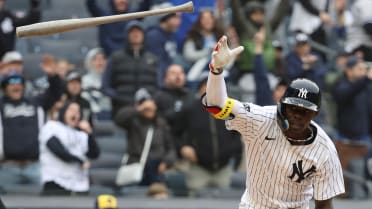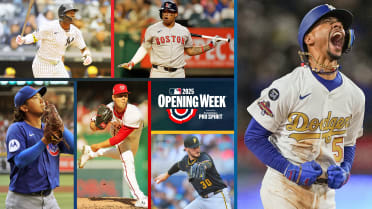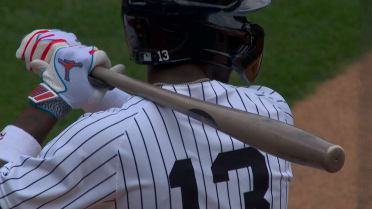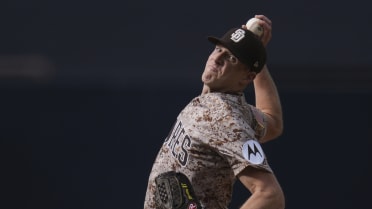A version of this story originally ran in December 2018.
Jack Zduriencik scurried toward the Bellagio ballroom where a late-night press conference announcing a trade was about to begin. This was at baseball's 2008 Winter Meetings in Las Vegas -- a town where impetuous action is not just accepted but expected practice. It's the place that, as Elvis taught us, is reserved for those with strong hearts, nerves of steel and a high tolerance for sleep deprivation.
It is, in other words, the perfect place to make a crazy baseball trade.
Zduriencik, then the general manager for the Mariners, had done just that. The three-team trade between his Seattle club, the Mets and Cleveland roped in a dozen different ballplayers and, combined with the news that same night that Brian Cashman's abrupt hotel checkout had resulted in the successful signing of CC Sabathia, brought buzz to the Bellagio. It was a trade that, like so many other Sin City situations, escalated quickly -- and with no prior publicly reported rumblings (this was before Twitter truly took off) and few industry whispers to tip off execs from the 27 clubs that weren't involved.
So when Zduriencik zipped past a table where the late Kevin Towers, gathered with his D-backs staff, motioned for him to stop and chat, the hurried reply was taken in jest.
"Kevin, I can't talk now," Zduriencik told Towers. "We just did a 12-player trade!"
Towers laughed.
"Yeah, yeah," Towers said dismissively. "Sure you did."
Oh, but the trade was real. The podium awaited. And the convoluted transaction announced that night is everything we love about baseball's Hot Stove swap season and the efficient deal-making environment that the Winter Meetings provide.
All these years later, let's delve into how it went down and how it turned out.
The Chips
Here's what the trade -- completed late in the evening of Dec. 10, 2008, and announced at a press conference shortly before midnight -- looked like:
Seattle gets: 1B Mike Carp, OF Ezequiel Carrera, OF Endy Chavez, RHP Maikel Cleto, RHP Aaron Heilman and LHP Jason Vargas from New York, and OF Franklin Gutierrez from Cleveland
New York gets: RHP J.J. Putz, RHP Sean Green and OF Jeremy Reed from Seattle
Cleveland gets: RHP Joe Smith from New York and INF Luis Valbuena from Seattle
"There was a lot going on," Smith said later. "It was a mess."
A mess? That's a fair assessment. But was this the biggest trade in Winter Meetings history? That's up to the beholder.
Remember that the Chris Sale-to-Boston blockbuster went down at the 2016 Winter Meetings, and in 2007 the Tigers traded for Miguel Cabrera. The legendary Toronto-San Diego swap of Tony Fernandez and Fred McGriff for Roberto Alomar was also a Winter Meetings special (1990), and in 1984 both the Mets (Gary Carter) and Yankees (Rickey Henderson) acquired Hall of Famers at the annual swapfest.
But if you want to get to the soul and sentiment we attach to the Winter Meetings -- an event that is supposedly designed to compel clubs into action they might not have otherwise accomplished -- then you really can't do much better than this epic three-way trade.
The Shuffle
It started with a September to forget for the Mets.
Granted, the Mets' fizzle in the home stretch of the 2008 season wasn't even as bad as their disastrous September of a season before. But it was epic enough to grease these particular trade wheels. They went 5-8 in the season's last two weeks to finish one game behind the Brewers in the National League Wild Card race, and the bullpen that was besieged by Billy Wagner's snapped elbow ligament posted an abominable 5.63 ERA in that span. The 'pen was the Mets' main miscreant and, ergo, GM Omar Minaya's main mark in the winter shopping season.
"We were in win-now mode, and we were looking to improve the bullpen," Minaya told MLB.com leading up to the trade's 10th anniversary in 2018. "The things people are trying to do now, we were trying to do back then. It was, 'Let's load up the bullpen and win the bullpen game.' And J.J. Putz was a key guy."
At the start of the Winter Meetings, Minaya already had traction with another key guy in closer Francisco Rodriguez. When the Mets increased a two-year, $24 million offer to three years and $37 million, they had agreement on a deal with K-Rod around 5 a.m. PT on Tuesday, the Meetings' second day.
With that move a physical examination away from completion, Minaya could get back to the business of landing Seattle's closer with the hope of turning him into K-Rod's setup man. He spent much of Tuesday and Wednesday trying to get it done.
Blessed with a strong arm and superb splitter, Putz was still considered one of baseball's best relievers. He had missed time in 2008 with rib cage and elbow injuries, but his velocity was up at season's end and he was not far removed from an All-Star season in 2007, when he saved 40 games.
The Mariners were coming off a 101-loss season and had just hired Zduriencik to reshape their system. They had no real use for a closer due to make $5.3 million in 2009 with an $8.9 million option for 2010, and Zduriencik was intent on improving his outfield defense. He took advantage of the ease of communication at the Meetings by having face-to-face conversations about Putz with a variety of clubs.
"When you're at those meetings," he said, "you have discussions with a lot of people."
On that Wednesday morning, Zduriencik was deep into Putz trade talks with the Tigers. Detroit ultimately balked at including both right fielder Matt Joyce and infielder Jeff Larish in the deal and wound up sending Joyce to Tampa Bay for starter Edwin Jackson. There were conversations with the Cardinals about Putz that involved Rick Ankiel (who had already converted to the outfield and had just hit 25 homers), but that deal never materialized. Zduriencik also had conversations about Putz with Cleveland, which by Wednesday was closing in on a two-year free-agent contract with closer Kerry Wood.
So the Mets, ultimately, made the most sense as a trading partner for Putz, but the two sides were having trouble hammering a deal home.
"Omar called me that afternoon," Zduriencik recalled, "and said, 'We can't get quite to where we're going, so would you mind if I brought a third club into this deal?'"
Zduriencik had just one request: "I need you to get me a center fielder."
The Deal
Minaya and Cleveland GM Mark Shapiro had a strong working relationship, and Shapiro's club had depth in its outfield and a need for depth in their infield. Minaya knew they liked Joe Smith, and he knew the Mariners liked Cleveland's defensively gifted outfielder Gutierrez. A couple phone calls between Minaya and Shapiro and then Shapiro and Zduriencik was all it took to put some basic pieces together.
Cleveland would work as a conveyor, sending Gutierrez to Seattle in exchange for Smith from the Mets and infield prospect Valbuena. This would get Zduriencik his center fielder, as well as a 30-year-old reliever in Heilman, a 26-year-old starter in Vargas (working his way back from hip and elbow surgery) and prospects in Cleto, Carrera and Carp. The Mets would get two relievers -- Putz and Green.
The M's interest in Gutierrez was part of a shift toward advanced metrics that was just beginning to consume baseball. Zduriencik had brought Tony Blengino with him from the Brewers to head Seattle's Department of Statistical Research, and he hired respected statistician Tom Tango as a scouting consultant. In the lead-up to the Winter Meetings, Tango was given a list of players to evaluate that included Gutierrez. He had a plus-or-minus methodology of evaluating a defender's impact on a play called WOWY (With Or Without You), and Gutierrez graded highly. So did one of the Mets' outfielders.
"I think the trade happened a few days after they first contacted me," Tango, who is now a senior data architect for MLB Advanced Media, wrote in an e-mail. "I had just started a few weeks earlier, I think. When it became apparent that SOME deal was going to go down, I asked, 'Can you look into getting Endy Chavez, too?'"
Just when it appeared the deal was in place, Minaya asked about Seattle outfielder Reed. In exchange for Reed, Zduriencik asked Minaya to chip in Chavez, who held a prominent place in the hearts and minds of Mets fans for making perhaps the greatest defensive play in franchise history but was just a year away from free agency and was a candidate to be non-tendered.
Maybe it wasn't a jackpot, but it was a done deal.
"It just seemed to make sense for everybody," Shapiro said.
From Seattle's perspective, especially, the trade appeared enormously complicated, given that it involved a seven-player return with very little proven pedigree. Often, though, trades don't come together "quickly" unless they involve months or even years of background work. Zduriencik's previous job as the Brewers' vice president of player personnel served him well, because Milwaukee had nearly done a deal for Gutierrez four years earlier, when Gutierrez was a prospect with the Dodgers. Zduriencik had scouted Chavez in the Minors and Vargas in college, had nearly taken Heilman with the No. 12 overall pick in the 2001 Draft and, of course, had Mariners scouts telling him how much they liked the rhythmically alliterative Minor League group of Cleto, Carrera and Carp. (And yes, he also had the input of his statisticians, with Tango particularly amazed at how quickly his input led to action in his first days on the job.)
"There was a lot of familiarity with the names," Zduriencik said.
And a lot of names, period, which is why Zduriencik made one last phone call to Minaya to confirm everything.
Around 3:30 p.m. PT on Wednesday, Minaya met with the Mets' beat reporters in his suite at the Bellagio. The interview session had just begun when the phone rang. Minaya answered aloud and then immediately shifted to a hushed tone. As Zduriencik spoke on the other end of the phone, Minaya said, "Uh huh, uh huh." He hung up, then conferred with assistant GM John Ricco and director of Minor League operations Adam Wogan behind a closed door in an adjacent room for a few minutes while the writers waited.
When Minaya returned, he distractedly fielded the writers' queries while visions of a beefed-up bullpen danced in his head.
"Just so you know, this thing came together when you guys were in the room," Minaya told the writers later. "You can tell I was a little bit ... my mind was wandering. I was getting the names, believe it or not. I was quiet as I could be."
Somehow, the deal was kept quiet ("You swear all of your people to secrecy," Zduriencik said, "but it doesn't always work") for several hours as medical records were exchanged and the 12 players were contacted. It wasn't until around 8 p.m. that word began to leak out, and over the next few hours national and team beat reporters pieced together the details with various blog reports.
In the 11 p.m. hour, the three GMs took to the podium for the official announcement. That Shapiro was relatively underdressed in relation to his jacketed peers was a window into how quickly and unexpectedly the deal had come together. He hadn't even packed a sport coat.
"The best thing I can say about this trade, guys, is it's an old-fashioned baseball trade," Minaya told the assembled reporters. "Here we are in the year 2008 and talking about millions of dollars, but this is how trades used to be done. Just a pure baseball trade."
The Pot
So, how'd it turn out?
Well, like the deal itself, the answer is complicated.
Mariners: Zduriencik was ultimately unsuccessful in building a winner in Seattle, but he did win this particular deal. Gutierrez was exactly the dynamic defender the M's were looking for. His 33 defensive runs saved in 2009 were the most of any Major League outfielder that year, making his solid .764 OPS a bonus. His bat sagged the following year, yet he won a Gold Glove, and the Mariners signed him to an extension. But by the start of 2011, Gutierrez had begun to battle the chronic inflammation of his spine and joints that would limit him to just 365 games the rest of his career.
"He was on his way to becoming a perennial All-Star," Zduriencik said. "He came up with that sickness, and … oh my God. It was a shame what happened to him."
Still, in addition to the value Gutierrez provided in what would have been the last two years of control of Putz, the Mariners also received four years of control of Vargas, who became an effective innings-eater in their rotation before getting dealt to the Angels in exchange for one productive season of Kendrys Morales in 2013. Heilman was flipped to the Cubs mere weeks after the 2008 deal went down, Carp and Chavez made negligible contributions to the M's (Chavez tore his ACL on a freak collision on the field), and Carrera was dealt midseason in 2010 when the Mariners briefly brought back Russell Branyan.
An underrated offshoot of the M's haul in the 2008 trade was Cleto, who had an undistinguished career himself but was used in a 2010 trade with the Cardinals that landed Brendan Ryan, one of the game's more valuable defensive shortstops at the time.
Cleveland: Though Gutierrez had shown some flashes of star potential, Shapiro's club had enough concerns about his durability and enough faith in the rest of its outfield composition to deal him. Losing Gutierrez's defense was a blow, but Smith eventually emerged as an integral piece in their 'pen, throwing 289 1/3 innings over the course of the 2009-13 seasons.
Cleveland may have missed an opportunity with Valbuena, who went on to a long and fine career after they designated him for assignment following the 2011 season. But Smith still made it a trade worth making.
Tragically, Valbuena and former big league infielder Jose Castillo died in a car accident in Venezuela on Dec. 6, 2018.
Mets: The Mets' September 2008 bullpen disaster was what prompted this trade, and the trade itself didn't turn out any better. It was far from the only issue that plagued the Mets in a 92-loss season in 2009 (their first at Citi Field), but it sure didn't help.
Putz had to have in-season surgery to remove a bone spur in his elbow and suffered a setback when he partially strained an elbow ligament. He pitched just 29 1/3 innings for the Mets and posted a 5.22 ERA. The club declined his 2010 option, but he went on to have a few more productive seasons with the White Sox and D-backs. The Mets also cut Reed loose after one year by non-tendering him.
That left Green, who spent part of 2009 in Triple-A, as the only piece of the deal that lasted more than one season in Queens. But he suffered a broken rib early in 2010 and didn't make it back to the club until September.
"I think it looked really good for the Mets going in," said Vargas, who wound up back with the Mets from 2018-19. "I'm guessing they were hoping that it went better than it did. The two most unexpected parts of that trade were probably Franklin Gutierrez and myself ending up having the length of career that I've had since then."
In the end, no deal in which Gutierrez and Vargas turn out to be the two most impactful pieces can be described as a blockbuster. But the sheer size of this swap, the remarkably rapid pace by which it came to be, and the specific, dice-rolling domain in which it occurred all contribute to make it an interesting example of deal dynamics.
"The key to that trade is the environment you're in, that Winter Meetings environment," said Minaya, who was fired by the Mets after the 2010 season only to return as a special advisor in 2017. "That trade can only happen at the Winter Meetings, because you're going from room to room and you're almost forced to have conversations with clubs. It forces things to happen."
But in the years since this trade was orchestrated, so much of the way front offices evaluate talent has changed.
Analytics are institutionalized, and decision-making models are unrepentant and unemotional. Back in 2008, execs would wax nostalgic about the days when trades were drawn up on bar napkins. Today, the notion of a deal actually being made face-to-face or even over the phone feels quaint, given the ubiquity of text and e-mail exchanges.
"That trade doesn't happen in today's game," said Shapiro, now the president and CEO of the Blue Jays, back in 2018. "No chance. It was very much a relationship-based deal, without a precise valuation of those players. In today's game, the ability to very precisely value players has a massive impact on the nature of deals in most cases, if not all cases. No one was doing it back then. I think, more and more, organizations are starting to value players on similar criteria, or at least in a similar way. So it takes a more precise alignment of needs, more than anything, and it's going to be hard to find that alignment with that many players involved."
So, sadly, don't look for any similar swaps to happen in the coming years. Just appreciate the fact that, one December day more than a decade ago, three baseball executives living devil may care kept pushing the stakes higher. Viva Las Vegas. And viva crazy trades.
Anthony Castrovince has been a reporter for MLB.com since 2004. Read his columns, listen to his podcast and follow him on Twitter at @Castrovince.




